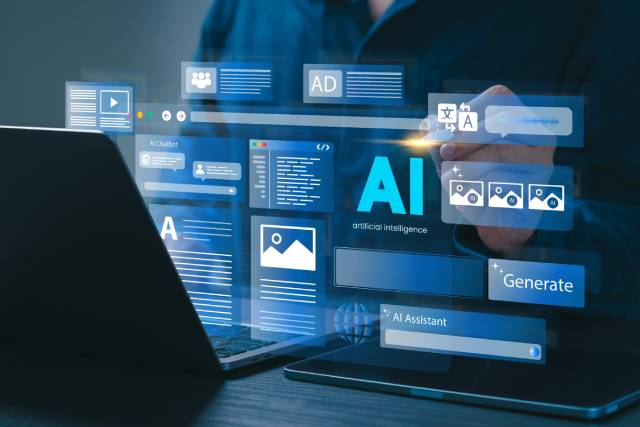Artificial intelligence (AI) is creating a major impact with unprecedented changes across the media and entertainment industry. From AI tools that can influence storylines and contextual advertising to crafting accurate personalization features and innovative tools for data security, discover how the industry is incorporating AI.
What is AI?

- Artificial intelligence (AI) is a wide-ranging branch of computer science concerned with building smart machines capable of performing tasks that typically require human intelligence. (Built In)
- AI systems work by ingesting large amounts of labeled training data, analyzing the data for correlations and patterns, and using these patterns to make predictions about future states. (Tech Target)

Generative AI techniques can create realistic text, images, music and other media. (Tech Target)
Generative AI refers to deep-learning models that can take raw data — say, all of Wikipedia or the collected works of Rembrandt — and “learn” to generate statistically probable outputs when prompted. (IBM)
When it comes to generative AI, it is predicted that foundation models will dramatically accelerate AI adoption in enterprise. (IBM)
Machine Learning vs. Deep Learning
Machine Learning

- A machine learning algorithm is fed data by a computer and uses statistical techniques to help it “learn” how to get progressively better at a task.
- ML algorithms use historical data as input to predict new output values.
Source: Built In
Deep Learning

- Deep learning is a method of artificial intelligence (AI) that teaches computers to process data in way that is inspired by the human brain.
- Deep learning models can recognize complex patterns in pictures, text, sounds and other data to produce accurate insights and predictions.
- Deep learning methods can be used to automate tasks that typically require human intelligence, such as describing images or transcribing a sound file into text.
Source: Amazon
Forecasts and Metrics
- The global AI market is expected to grow annual by 37% signaling its increasing importance across industries. (Hostinger, 2024)

- AI market size is expected to reach $407 billion by 2027, increasing significantly from its estimated $86.9 billion revenue in 2022. (Marketsandmarkets, 2024)
- The generative AI market is expected to reach 1.3 trillion by 2032 and 42% CAGR. (Hostinger, 2024)

- AI is projected to create around 97 million new jobs globally. (World Economic Forum, 2024)
- Over 40% of business leaders report increased productivity through AI automation. (Hostinger, 2024)
- And, almost two-thirds (64%) of businesses expect AI to increase productivity. (Forbes, 2024)
- Interest in AI website builders has grown 50% in the previous 12-months. (Hostinger, 2024)
- Media and entertainment has 5.29% of the total AI technologies market share with healthcare, finance and manufacturing sectors having the greatest share. (Hostinger, 2024)

- AI has the potential to boost workforce productivity and industry growth from 1.9% in arts, entertainment and recreation to 3.1% by 2035. (Hostinger, 2024)

Consumer AI Perceptions
- Over 70% of respondents are familiar with the term “generative AI,” and more than half (57%) say they’ve used a generative AI product like ChatGPT or others. However, only 18% are “very confident” they could explain to someone else what generative AI is or how it works. (Hub Entertainment Research, 2024)

- The vast majority of respondents have at least some concerns about AI, with two-thirds very worried about undetectable “deepfakes” and potential loss of privacy, and most (57%) worried about people losing their jobs to AI. (Hub Entertainment Research, 2024)

- While consumers strongly prefer human creativity for tasks like writing scripts, dialogue (59%) and music (63%), they are equally or more comfortable with AI handling technical tasks such as video editing to create backgrounds (51%) and dubbing dialogue from other languages (50%). (Hub Entertainment Research, 2024)

- Consumers are more comfortable with AI when it comes to better content discovery, as three-quarters of respondents said they were somewhat or very interested in AI applications to analyze their viewing across platforms to give better recommendations (76%), recommend shows for particular situations like watching with others (77%) or to summarize all the reviews of a show before they decide to watch (74%). (Hub Entertainment Research, 2024)
Consumer AI Use
- Half of U.S. mobile users use voice search every day. (UpCity, 2024)
- The most popular uses of AI include responding to messages (45%), answering financial questions (43%), planning a travel itinerary (38%) and crafting an email (31%). (Forbes, 2024)

- U.S. residents between the ages of 25 and 34 are the heaviest GAI users followed by 35-44 year olds. (Insider Intelligence)
- More than 20% of Internet users are predicted to be on the ChatGPT platform this year, up to 25% in 2024 and 26% by 2025. (Insider Intelligence)

- Over 75% of consumers are concerned about misinformation from AI. (Forbes, 2024)

- However, 65% of consumers say they’ll still trust businesses who use AI. (Forbes, 2024)
AI Programs
AI for Writing

ChatGPT is an artificial intelligence chatbot capable of producing written content in a range of formats, from essays to code and answers to simple questions. (Built In)
AI for Drawings / Visuals

Dalle-2 is an AI system that can create realistic images and art from a description in natural language

Snapchat filters use ML algorithms to distinguish between an image’s subject and the background. (Built In)
Location-Based AI

Google Maps uses location data from smartphones, as well as user-reported data. (Built In)
AI Personal Assistants

Personal assistants like Siri, Alexa and Cortana use natural language processing, or NLP, to receive instructions from users to set reminders, search for online information and control the lights in people’s homes. (Built In)
Wearable AI

The wearable sensors and devices with AI capabilities are mainly used in the healthcare industry to apply deep learning to assess the health condition of the patient. (Built In)
AI Recommendation Engines

AI-based recommendation systems are widely used in e-commerce to suggest products to users based on their browsing and purchase history, preferences and behavior. (IT Convergence)
Using past consumption behavior data, AI algorithms can help to discover data trends. (IBM)
Examples:



AI In Media
- Two-thirds (67%) of respondents said that any content made with AI should be “clearly and obviously labeled,” and another 26% said there should be an easy way for viewers to check if the title they’re watching contains any AI content. Only 6% said platforms don’t need to inform viewers about the use of AI. (Hub Entertainment Research, 2024)

Media Examples
Case Study | Netflix Recommendations: How Netflix Uses AI, Data Science, And ML

- Netflix AI generates thumbnails by annotating and ranking hundreds of frames taken from a preexisting movie or TV program to determine which thumbnails are most likely to prompt a click from users.
- It foresees how many subscribers it will have in the future. Therefore, it has room to make more technological advances.
- Netflix improves video quality for viewers even during busy viewing times by placing video assets near subscribers in advance.
- Because of Netflix AI, a single Netflix account may be used in two distinct locations, but you will be shown different recommendations in each. This algorithm learns on its own and continues to gather information.
- Netflix uses several machine learning algorithms that evaluate reviews, search terms, similarities, and many more variables. Then, they deliver personalized suggestions to their users.
- Article: Netflix Recommendations: How Netflix Uses AI, Data Science, And ML
AI in Marketing
Marketing
- Over three-quarters (76%) of marketers use Generative AI for basic content creation (76%) or to write copy (76%) with 58% reporting that it’s transforming their job when it comes to analyzing market data or performance data. (SalesForce/YouGov, 2024)

- Over seven-out-of-ten (71%) say generative AI will eliminate busy work and allow them to focus on more strategic work. (SalesForce/YouGov, 2024)
- Despite wide-use, 54% of AI users don’t trust the data used to train it with top concerns around Generative AI at work related to accuracy and quality (31%). (SalesForce/YouGov, 2024)
- While AI marketing use creates lots of opportunities, there is an acknowledgement of the lack of training and proficiency in these programs with 41% saying they don’t know how to get the most value of the technology or safely use generative AI (39%). (SalesForce/YouGov, 2024)
Resources

AI and Entertainment
Discover how AI is rapidly changing the way people are interacting with entertainment and technology, and how companies are embracing AI to streamline operations and improve efficiencies in producing, marketing and distributing content. Request an excerpt here.

CTAM Wired Webcast: Demystifying Artificial Intelligence in Media
In the rapidly evolving landscape of the media industry, AI is not just a buzzword; it’s a transformative force reshaping everything from content creation to distribution.
*CTAM Members only

ChatGPT Cheat Sheet (Hostinger.com)
Gain an introductory level to AI and ChatGPT with guidelines, resources and prompt tools to help with your marketing, web development, SEO and content creation.

Three Things Marketers Can Do Faster with Generative AI (SalesForce, 2024)
Generative AI is transforming marketing and helping marketers become more efficient. Discover more on how this technology can help marketers focus on innovation instead of getting bogged down with repetitive tasks.
Leveraging the Power of AI: A Guide for Executives
Insight Guide
Gain a comprehensive background on the impact of AI and discover how AI enhanced platforms can reinvent the relationship between your company and customers.



